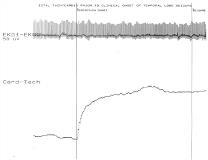HEART RATE ACCELERATION ACCOMPANYING EPILEPTIC SEIZURES
Abstract number :
E.05
Submission category :
Year :
2004
Submission ID :
5008
Source :
www.aesnet.org
Presentation date :
12/2/2004 12:00:00 AM
Published date :
Dec 1, 2004, 06:00 AM
Authors :
Richard C. Burgess, Elia M. Pestana, and Paul Shkurovich
We look for tachycardia as an adjunct to EEG analysis for on-line detection of epileptic seizures in our adult and pediatric epilepsy monitoring units. While acceleration of heart rate is a robust indicator of seizures, it occurs in only some patients. In temporal lobe epilepsy tachycardia occurs typically in more than 50%; an inconsistent correlation to the right hemisphere has been found. In addition, the time relationship between the tachycardia and other clinical manifestations is variable.
The pattern of tachycardia during seizures is unique in comparison with heart-rates during activities of daily living, showing an acceleration significantly higher and more abrupt (as seen in figure 1) than that in pseudoseizures. Partly to refine our tachycardia-based seizure detector, we sought to further characterize the tachycardia associated with seizures and to compare the acceleration pattern with normal controls. Video-EEG of seizures from patients manifesting seizures accompanied by tachycardia recorded over a 3 year period were reviewed. The EKG during each seizure and a 2-3 minute pre-ictal baseline period was converted to heart rate over a 5 minute epoch. Epochs were compared within and across patients. Handedness was determined by subjective report and by Wada testing. Side of seizure onset was determined by visual EEG analysis.
Six, healthy college-age control subjects were recruited for simultaneous EEG/EKG monitoring. The control subjects attempted to elevate their heart rates as quickly as possible during bicycle exercise and vigorous hyperventilation. Cardiotachographs of these recordings were also generated and compared with those from the epilepsy patients. Ictal tachycardia occurred in patients with both left and right temporal lobe epilepsy, as well as in patients with generalized motor activity. The tachycardia that occurred in temporal lobe epilepsy was either more abrupt or reached a higher maximum than the tachycardias induced in the control subjects. The heart rate acceleration pattern accompanying seizures was remarkably consistent within individual patients. Tachycardia was more likely during seizures with certain manifestations (e.g fear). In patients with tachycardia preceding other clinical manifestations, the pattern of acceleration is remarkably consistent and unique. This signatory pattern can be used as an early indicator of epileptic seizures.[figure1]Figure 1. In this temporal lobe seizure, the increase in heart-rate occurred approximately one and a half minutes before any clinical manifestations. (Supported by Cleveland Clinic Foundation)
